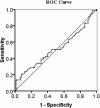The maximum standardized uptake value of 18 F-FDG PET scan to determine prognosis of hormone-receptor positive metastatic breast cancer
- PMID: 23368410
- PMCID: PMC3583732
- DOI: 10.1186/1471-2407-13-42
The maximum standardized uptake value of 18 F-FDG PET scan to determine prognosis of hormone-receptor positive metastatic breast cancer
Abstract
Background: Whether PET scan maximum standard uptake value (SUVmax) could differentiate luminal A from luminal B and help predict the survival of metastatic breast cancer (MBC) patients with luminal subtype is still unknown and need to be investigated.
Methods: 305 MBC patients with luminal subtypes were screened with PET/CT. Eligible patients were prospectively followed up.
Results: In total, 134 patients were eligible for this study. SUVmax was significantly related to the number of metastatic sites and presence of visceral metastasis on univariate analysis. SUVmax could not effectively differentiate patients with luminal A from luminal B subtype. Although luminal subtype at diagnosis could predict the relapse-free interval, it could not predict progression-free survival (PFS) or overall survival (OS) after developing relapse. In contrast, SUVmax was predictive of both PFS and OS and this effect was maintained in multivariate COX regression model.
Conclusions: SUVmax of MBC did not correlate with molecular subtypes of primary tumor. While molecular subtype may be a valuable prognostic factor at primary diagnosis of breast cancer, the SUVmax, rather than molecular subtype, does have a potential to predict independently in multivariate analysis for the PFS and OS in patients with metastatic disease of luminal subtype.
Figures



References
-
- Mariani G. New developments in the treatment of metastatic breast cancer: from chemotherapy to biological therapy. Ann Oncol. 2005;16(Suppl 2):i191–i194. - PubMed
-
- Sorlie T, Perou CM, Tibshirani R, Aas T, Geisler S, Johnsen H, Hastie T, Eisen MB, van de Rijn M, Jeffrey SS. et al.Gene expression patterns of breast carcinomas distinguish tumor subclasses with clinical implications. Proc Natl Acad Sci USA. 2001;98(19):10869–10874. doi: 10.1073/pnas.191367098. - DOI - PMC - PubMed
MeSH terms
Substances
LinkOut - more resources
Full Text Sources
Other Literature Sources
Medical

